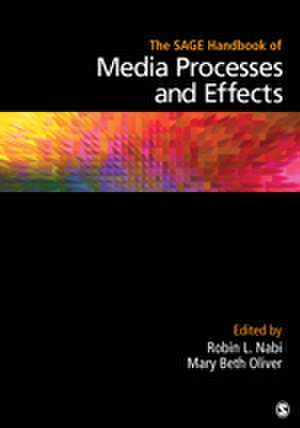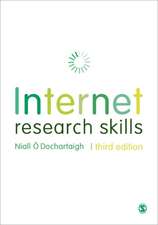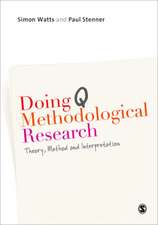The SAGE Handbook of Media Processes and Effects
Editat de Robin L. Nabi, Mary Beth Oliveren Limba Engleză Hardback – 5 oct 2009
Throughout the Handbook and within each chapter, authors address the following issues: (1) historical context on theory development/area of study; (2) theory explication and theoretical developments through to the present; (3) typical method of study/research approach/moderators; (4) conceptualization of the audience; (5) the impact of new media environments; (6) criticismsntroversies; and (7) directions for future research.
Section I: Begins with an overview of the field, conceptualization of media effects, and the editors' goals for the volume and then focuses on the range of methodologies (both quantitative and qualitative methods) used in the study of media effects.
Section II: Focuses on dominant theoretical approaches in the media effects area from a more societal perspective. Included here are some of the most dominant theoretical perspectives in the media effects realm (i.e., cultivation, agenda setting, framing) that relate to broad-reaching effects of both entertainment and news programming. The section then focuses on related theories that, though less developed, have received significant attention in the literature. To expand the horizon of this Handbook, a chapter on Cultural Studies in included to engage more qualitative views of media's societal effects.
Section III: Focuses on issues of message selection and processing that are central to the mass media literature. These chapters cut across application contexts. For examples, the emotion chapter touches on entertainment, persuasion, and children's media; the Social Influence/Environmental Aspects chapter includes issues of co-viewing in families, among peers, etc.
Section IV: Refelcts a dominant trend in media effects literature – that related to persuasion and learning – and traces its theoretical perspectives (including major theories of persuasion and especially social cognitive theory) through the various contexts in which media have such effects, such as health, advertising, media literacy, and the like.
Section V: Explores the contexts and audiences that have been traditional foci of media effects research – violence, children, body image, video games, sports, etc. In each chapter authors address the theories most applicable to those contexts, further expaning the theoretical offerings of this Handbook. The focus on how this sort of research is typically conducted methodologically and how it will need to change in light of new technologies and media advances make these chapters unique.
Section VI: Expands on existing work by focusing on a concern central and unique to the communication discipline – message medium – and how it influences effects ranging from what messages are attended to (e.g., formal features), how we spend our time (e.g., displacement effects), and even how we think (e.g., medium theory).
Preț: 1094.26 lei
Preț vechi: 1498.98 lei
-27% Nou
Puncte Express: 1641
Preț estimativ în valută:
209.45€ • 227.59$ • 176.05£
209.45€ • 227.59$ • 176.05£
Carte tipărită la comandă
Livrare economică 21 aprilie-05 mai
Preluare comenzi: 021 569.72.76
Specificații
ISBN-13: 9781412959964
ISBN-10: 1412959969
Pagini: 656
Dimensiuni: 178 x 254 x 41 mm
Greutate: 1.29 kg
Ediția:1
Editura: SAGE Publications
Colecția Sage Publications, Inc
Locul publicării:Thousand Oaks, United States
ISBN-10: 1412959969
Pagini: 656
Dimensiuni: 178 x 254 x 41 mm
Greutate: 1.29 kg
Ediția:1
Editura: SAGE Publications
Colecția Sage Publications, Inc
Locul publicării:Thousand Oaks, United States
Recenzii
"Nabi and Oliver organize their book more categorically and provide what they call a bird's-eye view of the field, chapters put the various theories into historical perspective. The emphasis on new media also sets this volume apart from the others and makes it a worthy addition to the literature."
Cuprins
PART I. CONCEPTUAL AND METHODOLOGICAL ISSUES
1. A Retrospective and Prospective Look at Media Effects - Jennings Bryant, Dolf Zillmann
2. Conceptualizing the Audience - W. James Potter
3. Quantitative Methods and Causal Inference in Media Effects Research - Itzhak Yanovitzky, Kathryn Greene
4. Qualitative Methods - Thomas R. Lindlof
PART II. SOCIETY, POLITICS, AND CULTURE
5. Cultivation Analysis and Media Effects - Michael Morgan
6. Framing and Agenda Setting - Dhavan V. Shah, Douglas M. McLeod, Melissa R. Gotlieb, Nam-Jin Lee
7. The Influence of Presumed Media Influence: Origins and Implications of the Third-Person Perception - Nurit Tal Or, Yariv Tsfati, Albert C. Gunther
8. News and Poliltics - Vincent Price, Lauren Feldman
9. Media Effects and Cultural Studies: A Contentious Relationship - Toby Miller
PART III. MESSAGE SELECTION AND PROCESSING
10. Uses and Gratifications: An Evolving Perspective of Media Effects - Alan M. Rubin
11. Entertainment - Mary Beth Oliver
12. Current Research in Media Priming - David R. Roskos-Ewoldsen, Beverly Roskos-Ewoldsen
13. The Limited Capacity Model of Motivated Mediated Message Processing - Annie Lang
14. Emotion and Media Effects - Robin L. Nabi
15. Mediated Relationships and Media Effects: Parasocial Interaction and Identification - Jonathan Cohen
16. Individual Differences in Media Effects - Marina Krcmar
17. Media Use and the Social Environment - Daniel G. McDonald
PART IV. PERSUASION AND LEARNING
18. Theories of Persuasion - Daniel J. O'Keefe
19. Social Cognitive Theory and Media Effects - Frank Pajares, Abby Prestin, Jason Chen, Robin L. Nabi
20. Emerging Issue in Advertising Research - L.J. Shrum, Tina M. Lowrey, Yuping Liu
21. Media Effects and Population Health - K. Viswanath, Sherri Flynt Wallington, Kelly D. Blake
22. Educational Television - Marie-Louise Mares
23. Media Literacy - W. James Potter, Sahara Byrne
PART V. CONTENT AND AUDIENCES
24. Violent Media Effects - Brad J. Bushman, L. Rowell Huesmann, Jodi L. Whitaker
25. Racial/Ethnic Stereotyping and the Media - Dana E. Mastro
26. Media and the Body - Kristen Harrison
27. Media and Sexuality - Jane D. Brown
28. Perceptions of Media Realism and Reality TV - Alice E. Hall
29. The Effects of Viewing Televised Sports - Arthur A. Raney
30. Digital Games - Peter Vorderer, Ute Ritterfeld
31. Children and Adolescents: Distinctive Audiences of Media Content - Barbara J. Wilson, Kristin L. Drogos
PART VI. MEDIUM ISSUES
32. Diffusion of Innovations: Theoretical Extensions - Ronald E. Rice
33. Displacement Effects - Jennings Bryant, Wes Fondren
34. Medium Theory: An Alternative to the Dominant Paradigm of Media Effects - Joshua Meyrowitz
35. The Evolution of Media System Dependency Theory - Sandra J. Ball-Rokeach, Joo-Young Jung
36. Media Effects 2.0: Social and Psychological Effects of Communication Technologies - S. Shyam Sundar
37. The Study of Media Effects in the Era of Internet Communication - Miriam J. Metzger
1. A Retrospective and Prospective Look at Media Effects - Jennings Bryant, Dolf Zillmann
2. Conceptualizing the Audience - W. James Potter
3. Quantitative Methods and Causal Inference in Media Effects Research - Itzhak Yanovitzky, Kathryn Greene
4. Qualitative Methods - Thomas R. Lindlof
PART II. SOCIETY, POLITICS, AND CULTURE
5. Cultivation Analysis and Media Effects - Michael Morgan
6. Framing and Agenda Setting - Dhavan V. Shah, Douglas M. McLeod, Melissa R. Gotlieb, Nam-Jin Lee
7. The Influence of Presumed Media Influence: Origins and Implications of the Third-Person Perception - Nurit Tal Or, Yariv Tsfati, Albert C. Gunther
8. News and Poliltics - Vincent Price, Lauren Feldman
9. Media Effects and Cultural Studies: A Contentious Relationship - Toby Miller
PART III. MESSAGE SELECTION AND PROCESSING
10. Uses and Gratifications: An Evolving Perspective of Media Effects - Alan M. Rubin
11. Entertainment - Mary Beth Oliver
12. Current Research in Media Priming - David R. Roskos-Ewoldsen, Beverly Roskos-Ewoldsen
13. The Limited Capacity Model of Motivated Mediated Message Processing - Annie Lang
14. Emotion and Media Effects - Robin L. Nabi
15. Mediated Relationships and Media Effects: Parasocial Interaction and Identification - Jonathan Cohen
16. Individual Differences in Media Effects - Marina Krcmar
17. Media Use and the Social Environment - Daniel G. McDonald
PART IV. PERSUASION AND LEARNING
18. Theories of Persuasion - Daniel J. O'Keefe
19. Social Cognitive Theory and Media Effects - Frank Pajares, Abby Prestin, Jason Chen, Robin L. Nabi
20. Emerging Issue in Advertising Research - L.J. Shrum, Tina M. Lowrey, Yuping Liu
21. Media Effects and Population Health - K. Viswanath, Sherri Flynt Wallington, Kelly D. Blake
22. Educational Television - Marie-Louise Mares
23. Media Literacy - W. James Potter, Sahara Byrne
PART V. CONTENT AND AUDIENCES
24. Violent Media Effects - Brad J. Bushman, L. Rowell Huesmann, Jodi L. Whitaker
25. Racial/Ethnic Stereotyping and the Media - Dana E. Mastro
26. Media and the Body - Kristen Harrison
27. Media and Sexuality - Jane D. Brown
28. Perceptions of Media Realism and Reality TV - Alice E. Hall
29. The Effects of Viewing Televised Sports - Arthur A. Raney
30. Digital Games - Peter Vorderer, Ute Ritterfeld
31. Children and Adolescents: Distinctive Audiences of Media Content - Barbara J. Wilson, Kristin L. Drogos
PART VI. MEDIUM ISSUES
32. Diffusion of Innovations: Theoretical Extensions - Ronald E. Rice
33. Displacement Effects - Jennings Bryant, Wes Fondren
34. Medium Theory: An Alternative to the Dominant Paradigm of Media Effects - Joshua Meyrowitz
35. The Evolution of Media System Dependency Theory - Sandra J. Ball-Rokeach, Joo-Young Jung
36. Media Effects 2.0: Social and Psychological Effects of Communication Technologies - S. Shyam Sundar
37. The Study of Media Effects in the Era of Internet Communication - Miriam J. Metzger
Descriere
Comprehensive exploration of where media effects research has been in the last 20 years, andwhat the future might hold for the field as rapid changes in the media environment continue.





